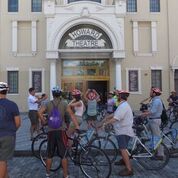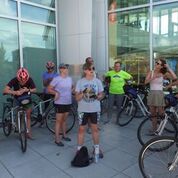Biking and SafeTrack – Highlighting the Need for Bike Infrastructure
Transit and bikes go hand in hand. Not only can riders bike to and from stations for that first and last mile, but biking is a great way to get around when Metrorail is under maintenance. It’s important that our policy makers understand the importance of having good bike infrastructure.
On Sunday, September 18th, I rode around DC with a bunch of planners from across the country in town for the American Planning Association’s (APA) annual Policy and Advocacy Conference. This annual conference gears planners up to advocate for federal, state and local policies that advance good planning principles through the legislative process. There are two days of training workshops and speaker sessions and an entire day of meetings on Capitol Hill, where planners meet with their representatives to discuss planning issues and their importance to creating strong communities.
One of the training sessions sponsored by the APA Virginia Young Planners Group (YPG) was a mobile workshop on bicycle infrastructure planning and the role of the bicycle as a viable transportation option. I was there as a speaker to provide some background about bicycling as an alternative for riders trying to get around during our SafeTrack rebuilding program. Two other speakers very familiar with the biking world here in DC were on the tour as well – Jim Sebastian, who manages DDOT’s Active Transportation Branch and is their chief bike planner responsible for most of the DC bicycling infrastructure that has come on-line in the last decade and helped make DC #4 in the country for bike commuting, and Doug Smith, WABA’s Everyday Bicycling Coordinator.
Doug led off the ride with a little WABA history noting that the advocacy group started out in the 70s with just ‘one guy’ who wanted a curb cut and now has 16 staff members dedicated to bike advocacy and education, along with some 5,000 members. We then proceeded up 15th Street NW on the cycletracks to T St., and headed over to the beautiful Howard Theater where Jim highlighted the successes (and some challenges) DDOT has had in adding new bike infrastructure around the city. After that, it was on to the the Shaw Metro Station for the SafeTrack portion of the session.
After I provided some background on SafeTrack to the workshop participants, Jim, Doug and I highlighted the various actions that our partners and Metro have taken to help our riders get around during the surges. WABA developed maps and signs and led bike convoys; Capital BikeShare (CaBi) began offering a $2 one-way fare, making it easy to grab a bike and go without needing a membership. They also installed CaBi corrals at locations where riders would collect and likely exceed existing hub capacity. Local planners in Arlington & Alexandria and Montgomery County also created wayfinding signage to point the way for riders during the Blue/Yellow and Red Line surges. The workshop attendees were impressed at the level of local collaboration we are achieving here to support our rebuilding program and help get us through a challenging time.
And, these efforts are paying off. From the very first Surge – out on the Orange and Silver Line – we saw biking making a difference. The Planning Office’s early analysis suggested that WABA and Arlington’s efforts helped avoid overcrowding west of Ballston. Of the 20-25,000 trips/day diverted from Metrorail, about 1,500-2,000 of them may have diverted to bicycling. We’ve also been asking our riders impacted by the Surges about how they’ve been getting around. After the first quarter of SafeTrack work (nearly 5 Surges) we found that at least four percent of Surge-impacted customers had used personal bikes or Capital Bikeshare for full or partial trips. Hooray for pedal power!
Obviously, we aren’t through this yet and with winter coming, biking may prove to be a more challenging option. But, we’ve been very fortunate to have partners like WABA, DDOT and the bike planners in our other jurisdictions helping us to date. Without their actions and cycling infrastructure, this option may not have been as viable for our riders as it has been. They have been very nimble and dedicated in their efforts and though biking may not be an option for everyone, it may be an option that some will consider for accessing their station when Metrorail is back up and running at full speed.
In the meantime, APA should have some good fodder to bring to the Hill in support of bike infrastructure, and we have even more reason to support bicycling infrastructure leading to our stations.




Recent Comments